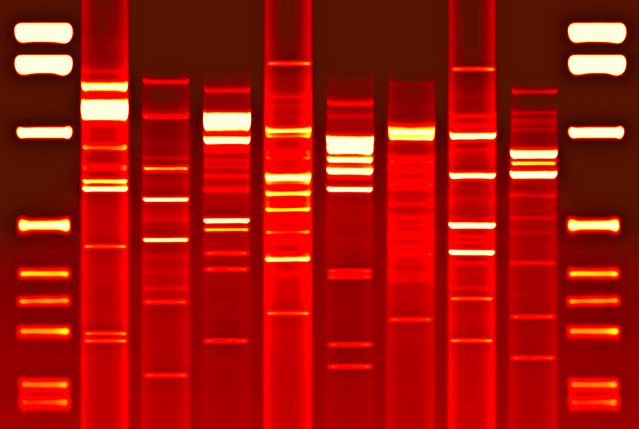Genetics
DNA Imaging: Icon of a New, Genomic Literacy
What sacred icons once were to religion, images of DNA now are to science.
Posted June 27, 2016

The illustration above is my DNA Portrait, given to me by my family for my 70th birthday. They could hardly have thought of a more apt present for someone who likes to think in pictures and whose thinking nowadays is mainly focussed on the imprinted brain theory: or how, to quote the subtitle of my book on the subject, genes (which are of course written in DNA) set the balance between autism and psychosis.
You can find technical details on the DNA 11 website, but basically what the image represents is strings of my DNA cut at the 8 most common 10-base sequences in the human genome (the latter explained in more detail in a previous post). This yields strings of different length DNA which are then drawn through a gel by electrical attraction so that they form bands sorted by their length, longest at the top, shortest at the bottom, thickness determined by number of fragments of that size. The outermost columns are standard reference lanes; the second on the left the most common sequence (GTGAGGCGTC), and second on the right, the least (GTCGCCGTCA). Everyone will have a uniquely different pattern, just like fingerprints.
But this is just the start of it:
Routine molecular biologic digitization of humankind is just around the corner… In 2011, the iPad app Genome Wowser became available to graphically review the findings of any individual’s genomic variants. Being able to explore one’s genome by manipulating a tablet screen is a particularly dynamic experience. (p. 119)
And where DNA graphics like that above are concerned, a strikingly aesthetic one as well!
But this beautiful, glowing image is more like a stained glass window people might have seen in churches in the Middle Ages. Such pictures may be ravishing, but what do they mean? The stained glass portrayed lives of the saints and stories from the Bible, and rather like our relation to DNA today, were in fact little more than icons because the majority of those who worshipped them had no access to the texts on which they were based. Written in Latin, the literature of the Church was a closed book to the largely illiterate, non-Latin speaking laity. But again, something similar is also true of DNA, particularly as it pertains to health issues:
To say that this information has to be routed through your doctor is a little like the Middle Ages, when only priests were allowed (or able) to read the Bible. Gutenberg came along with the printing press even though few people were able to read. This triggered a literacy/literature spiral that had incredible benefits for civilization, even if it reduced the power of the priestly class. (pp. 120-1)
The modern priestly class most concerned, the medical profession—not to mention the laity—thinks of genes primarily as a cause of illness: indeed, even more so if the illnesses are mental ones. Not surprisingly then, the discovery that genes can both cause and protect against different illnesses at the same time seems deeply counter-intuitive. Nevertheless, a recent study based on data from almost 5 million Danish subjects revealed that risk of an autism spectrum disorder as indicated by birth size varies inversely with risk of a psychotic spectrum one.
This is just as predicted by the imprinted brain theory, which proposes that genes from the parents are in conflict over how to build the body and brain of their child. Paternal genes push for increased growth and development in an autistic direction, and maternal ones push for reduced growth and development in the psychotic one, with potentially disastrous consequences for the child’s mental health if the conflict is not resolved equitably. Such a surprising insight into the role of genes in development may seem like science fiction today, but as the posts on this site increasingly reveal, is very likely to be the science fact of tomorrow.
Literal interpretation of the Bible came into conflict with science, first with Copernicus’s discovery of the sun-centered solar system, and more recently with Darwin’s discovery of evolution by natural selection. The result is that today even the Pope does not take the biblical text literally! And whatever else you might say about the imprinted brain theory’s interpretation of the role of genes in development, it cannot be accused of literalism in interpreting DNA. On the contrary, the theory gives the lie to the simplistic belief that genes control behavior directly and robotically, and instead sees the brain as an organ built for and on behalf of conflicting genes to make difficult choices in real time for which DNA could not possibly legislate in advance.
However you look at it, DNA images are iconic in more senses than one. Indeed, you could see them as the sign, not only of a revolution in science that has only just begun, but of an advance in literacy which is likely to be every bit as far-reaching as that which ushered in the modern world. Where reading the genomic Bible is concerned, the end of the Middle Ages is in sight!


